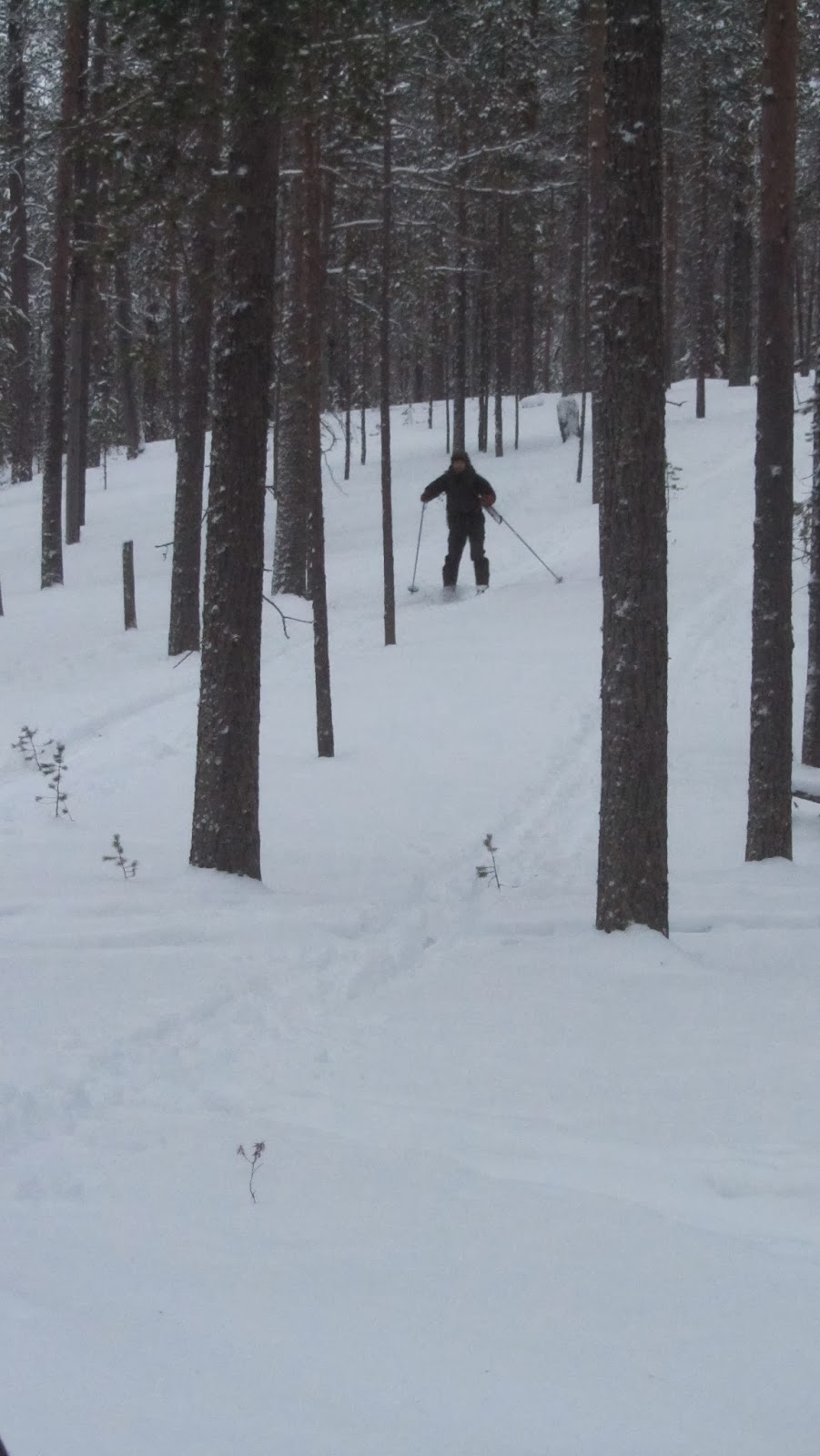I'm back from a few weeks spent in Kainuu so I have a few things to post, but first things first. The forest skiing trip.
I was on a week long skiing trip with the course in a place called Hossa in Kainuu. Really nice area I'll definitely be going there again. The trip was basically a practise run for the solo ski trip in four weeks time. Apart from a short training day in Kuru this was the first time most of us had any sort of real skiing time using the forest ski's. They are like cross country ski's, but bigger. Almost three metres long and twice as wide as track ski's. They are go anywhere ski's, the size of them keeps you nicely on top of the snow, much better than snowshoes! No need to keep to the maintained tracks, with these ski's you make your own tracks.


Obviously to start with I have to make my camp.This was the first time I had set up the shelter in snow so it was a little different than usual, but after a little messing around and a little more digging I had something that was going to have to do cos it was getting late. I had to dig my fireplace down to the ground or else it would've disappeared into the snow after a few minutes. I got a fire on the go and made a cup of tea before bed and had a really good nights sleep.


After two nights the original camp wasn't working too well, the shelter was sagging, the sleeping place was icy and uncomfortable. Instead of just fixing it I moved to a new location. I pitched the shelter alot higher giving me much more room inside and even tho it was snowing a fair bit not much came inside the shelter. My fire going at night was further away from the tree than it looks, but still I wouldnt make it that close in summer. The ground was nice and frozen and I only had a small fire so the tree was quite safe.
We have been told that in summer time you have to be careful that you are far enough from trees so that there are no big roots under your fire as they are full of resin and if too hot can start a fire underground spreading to the tree and the tree will almost burst into flames and good luck putting that one out.
We had breakfast at the lean-to every morning prepared by the daily cooking group and set off for skiing over the lake at around eight lead by the daily guides orienteering to various locations. Some people pulled the sledges, we rotated the sledge pulling after lunch to make sure everyone had a go because on the solo ski we're gonna be pulling these bad boys loaded right up for 9 days. We had a few different types of sledge, I don't know which I'm gonna get for the solo ski trip? its going to be a lottery, but I hope its one of the bigger ones.


Even tho it had been quite warm and there was some water on top of the ice in some places, there was still about half a metre of solid ice underneath us so no danger of falling in, but we practised a few saftey measures. Like using local knowledge, we could see that snowmobiles had recently been on the ice and had avoided the middle of the lake, so it was wise for us to do the same and we followed their tracks around narrow areas of the lake. Also unclipping our ski bindings, back packs and sledges so that if the ice did give way we could easily shake off the extra weight and hopefully pull ourselves out.
Water at river mouths, under bridges and areasof strong current often stay open and wont freeze over unless it gets very cold or there is a long spell of cold weather, to be on the safe side its best to avoid those areas anyway.
We wern't always on the water tho. We had to ski and pull the sledges through the forest and up hills, it was not always easy. Especially for those at the front making new tracks in deep snow.

We carried all pots n' pans, water butts, food and everything for cooking lunch with us in the sledges. On this trip all main meals were communal and cooked by the daily cooking group. I dont remember who did the food plan for the week? but the meals were really good.
What goes up must come down and sometimes we came down hard! There are no pictures of my falls, but I had more than my fair share of crashes. Actually, at the bottom of the picture above of Seishi coming down a hill with a sledge you can see one of my landing spots.
It was a good week in all, even tho I fell over way too much, but I learnt alot about skiing and what I need to do before the solo trip.
Before I go, here are some more pics of Andy. He seems to get into a lot of my pictures. It was his birthday a while ago and he started some weird tradition in his village in Belarus some years ago that on your birthday you have to go outside and pour a bucket of cold water on yourself. I dont know why??
If the video works I'll put more on in the future.
Laters




























































